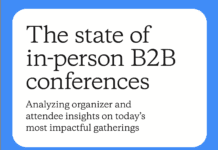
Bizzabo data shows that in-person events are ramping up quickly — almost everyone (99%) surveyed over the summer had at least one event on the docket for this year, and 83% said they plan to host at least three in-person events this year. But that doesn’t mean that event organizers are moving away from virtual and hybrid. In fact, 68% plan to have a virtual component at their next in-person event, and 53% of organizers are “focused” or “very focused” on a virtual events strategy for 2023.
Trends data collected by Bizzabo over the summer reaffirm that the return to in-person events was no blip — fully 99% of event organizers said they had at least one event scheduled for this year, and 83% said they plan to hold three or more in-person events before 2022 fades into the sunset.
And the outlook for in-person events is even rosier for 2023, with 85% saying they are planning at least three in-person meetings and 35% saying they have at least 10 or more on the books for next year. The most robust return, according to the Bizzabo data, is trade shows and expos, at 45%. Industry conferences and private events were close behind at 43% each, while field marketing events and multi-department meetings were being planned by 32% and 30%, respectively.
Does that mean virtual events are over now that COVID restrictions have eased? Not exactly. In fact, according to Bizzabo’s data, 68% plan to include at least some virtual components for upcoming in-person events. About half 52%, said they are either “focused” or “very focused” on a virtual events strategy for next year. Why? Mainly because we still are working through a COVID-related hangover, with 27% saying they still aren’t sure they’re ready to return to fully face-to-face events.
Prevue recently caught up with Lauren Grady, Director of Bizzabo’s Global Event Center of Excellence, to learn more.

Prevue: To what do you attribute the finding that almost everyone surveyed said they had at least one in-person meeting coming up in 2022, with even more slated for 2023?
Grady: Due to the pandemic, in-person events were limited or nonexistent. As Bizzabo data shows, attendees and event organizers are eager for the reverse pivot back to in-person events as there was a pent-up demand for face-to-face interactions and networking. During the pandemic, the lack of networking opportunities left a void felt by attendees. Virtual events work well for learning and educational sessions like webinars. But in-person and hybrid events provide the human connection organizers, attendees, sponsors, and exhibitors have been missing these last two years. In-person events foster deeper connections that extend beyond a single event, transforming networking opportunities into moments that build communities. And while event professionals gained access to valuable data insights during their pivot to virtual, new technologies are enabling unparalleled onsite data capture. Incorporating technology like wearables gives organizers the best of both worlds — insight into behavioral data, additional engagement opportunities, and real-time experimentation to improve event outcomes — while they get to do what they love: bringing people together.
Prevue: Why do you think such a large percentage of respondents say they want to include at least some virtual elements to their upcoming in-person events?
Grady: In-person events with virtual components will factor heavily in the events landscape going forward. Over the last two years, virtual events lowered some of the common barriers — like travel and ticket costs — that can prevent people from attending events. Incorporating digital event components into upcoming in-person events adds a valuable layer of flexibility, empowering attendees to decide how they want to experience an event. Virtual elements provide data on engagement and preferences and can cut down on environmental impact and improve sustainability efforts. These elements have many benefits, including lower production time, cost, and accessibility, which is why virtual elements will continue to be part of in-person events.
Prevue: What data from the survey backs up the need to go hybrid, at least for the near term?
Grady: Event professionals who responded to Bizzabo’s survey identified three of the top attendee priorities as COVID-19 safety (46%), travel considerations (44%), and time investment (39%). These priorities can be barriers to attending in-person events, especially for attendees dispersed across the globe. Event organizers must provide solutions or alternatives that allow attendees to choose the path to attendance — and engagement — that meets their needs.
Prevue: It’s interesting that the Bizzabo data shows attendance as still being the top success metric, trailed by engagement. Do you think this holds true for both in-person and digital events, or do you think there may be a difference in how event organizers measure the success of a digital event, as opposed to an on-site meeting?
Grady: The question was not specific to a certain event type, but it’s not surprising to me that attendance is still listed as the top success metric. This actually does show a bit of an evolution from a focus on the number of registrations, since a no-show rate for virtual events is on average anywhere from 35-50%, and hotels have indicated an increase in room reservations three weeks prior to in-person events. There’s much more of an emphasis on the registration-to-attendee conversion rate.
Engagement being #2 aligns with how many are redefining event success as not stopping at the attendance number but understanding how engaged attendees are with the event and brand. From there, you can assess if the more highly engaged attendees correlated to more sales-qualified leads.
Prevue: Do you have any predictions on how the in-person/hybrid/fully virtual trends could evolve over the next six months? 12 months?
Grady: Over the next year, we will continue to see event organizers experiment with ways to make events more human. But as economic uncertainty continues, event professionals will also be asked to do more with less. Whether their event is in-person, hybrid, or virtual, organizers will need to adopt technology that empowers them to demonstrate the value of their events. They’ll need to align event strategies with broader business goals and use each event type with intentionality to progress toward those goals. Pipeline will become the ultimate measure of success for events, and organizers who understand how to collect and activate the right data will be in the best position to make their case for each kind of event.
I’ll just end by saying that in-person events are not displacing virtual or hybrid events. They are providing even more opportunities to drive business impact and fuel revenue goals. I really see a future where attendees move fluidly between virtual and physical experiences.
View the infographic summarizing the Bizzabo data trends here.
You May Also Be Interested in…
Live Events Rank High With Associations
Incentive Travel Index Finds Safety and Affordability To Be Top Priorities
Amex GBT Survey Forecasts Increases Across the Board for 2023










